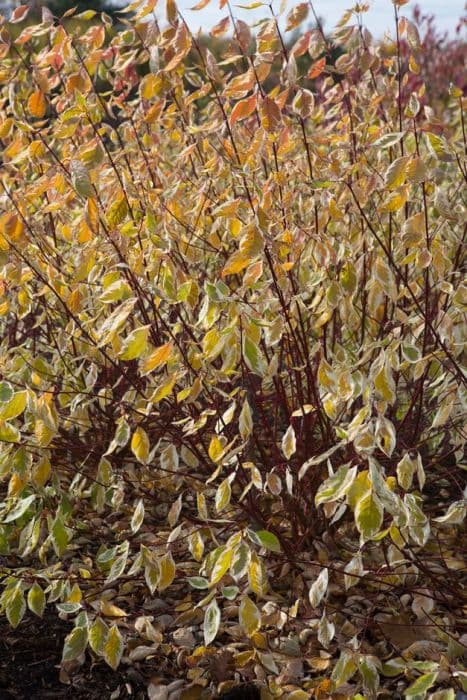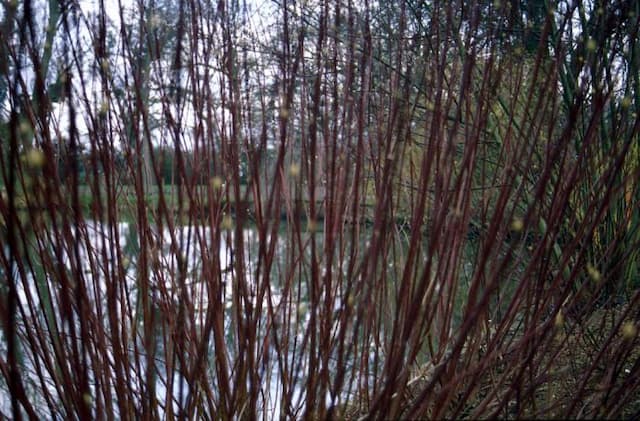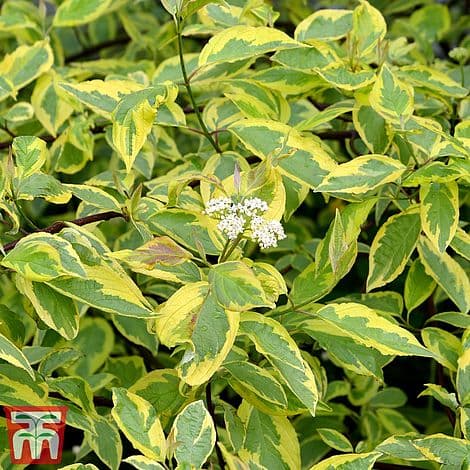Kousa Dogwood Cornus kousa 'Schmetterling'
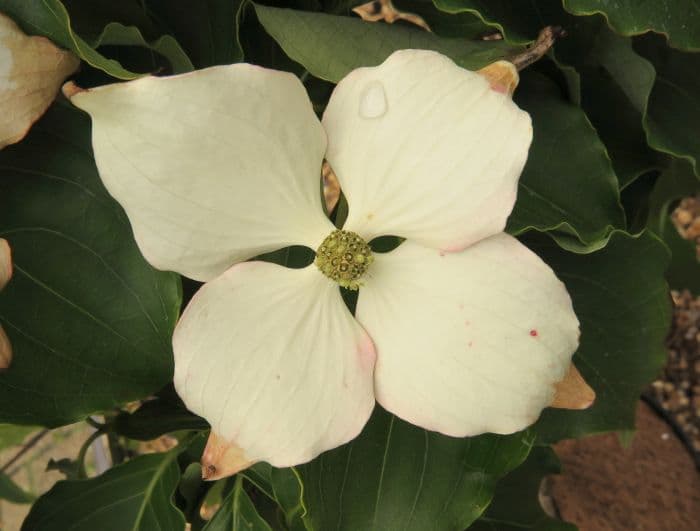

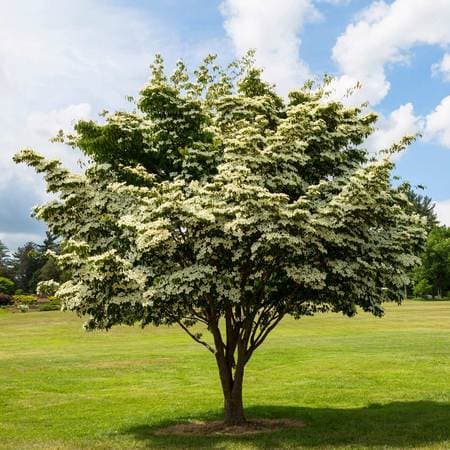
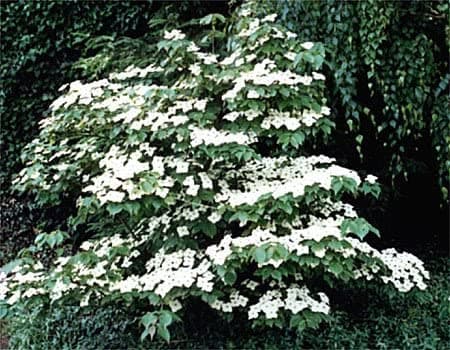
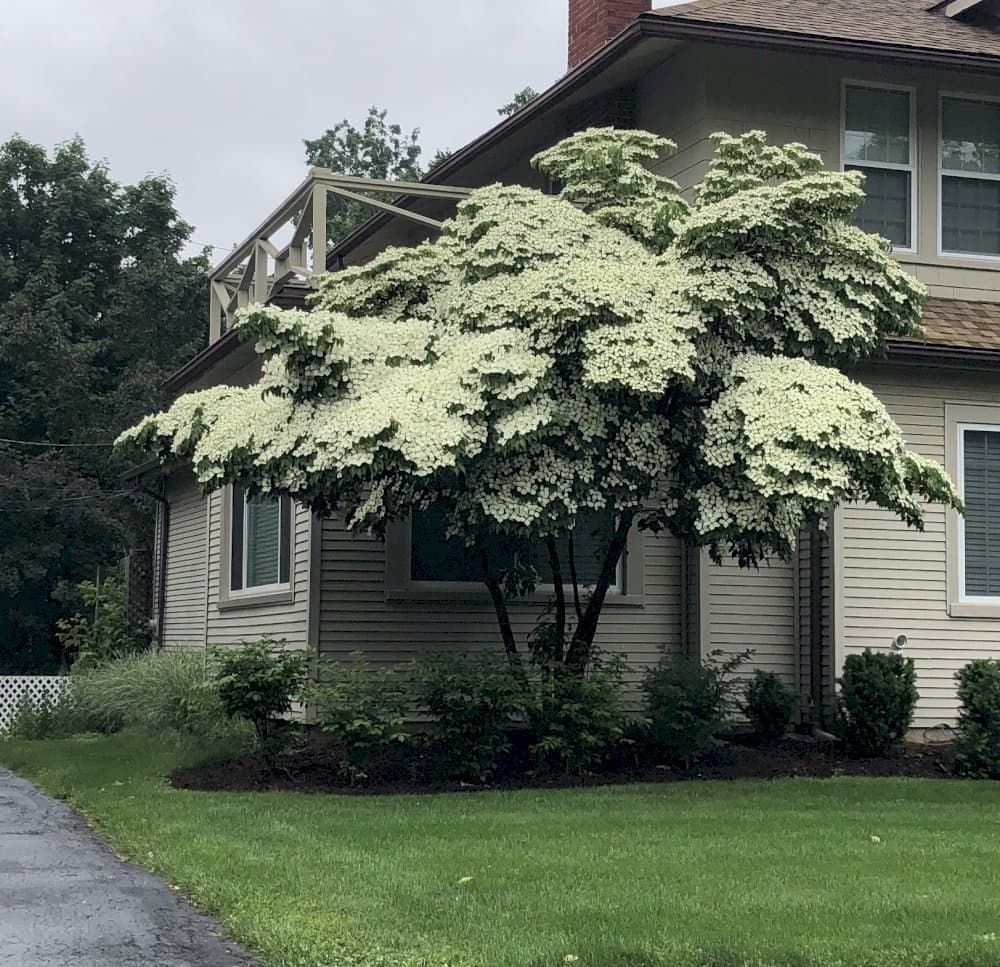
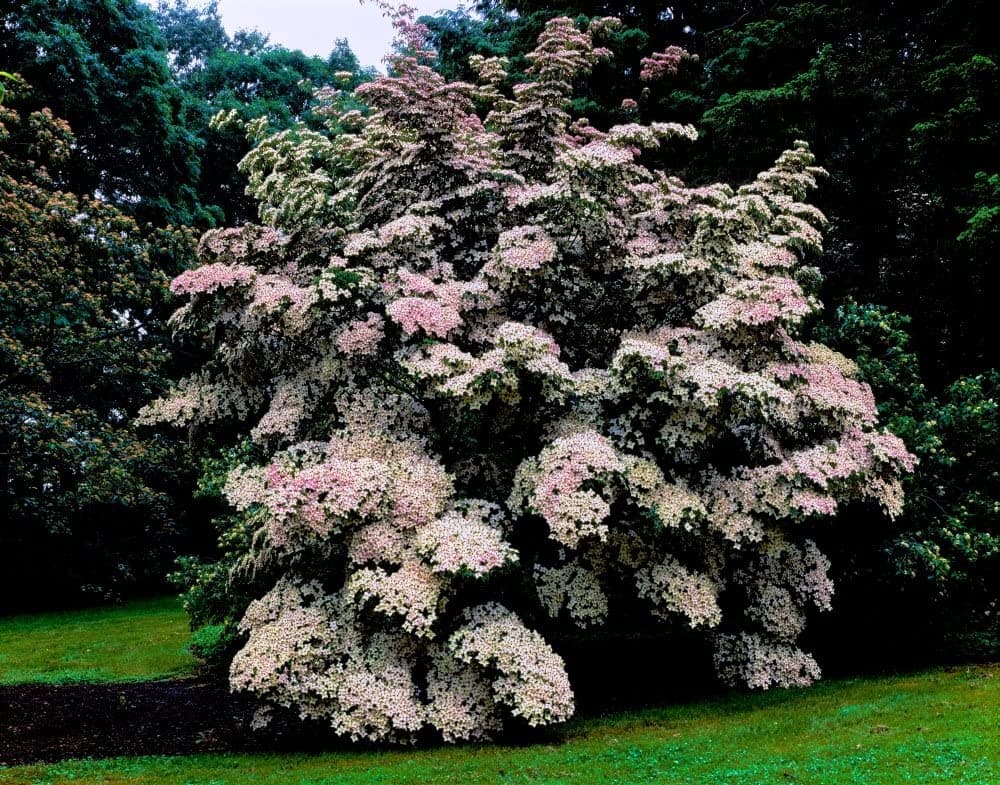
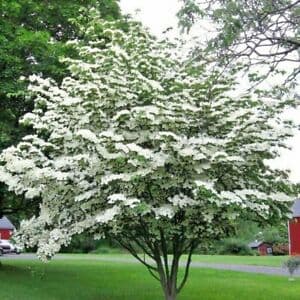

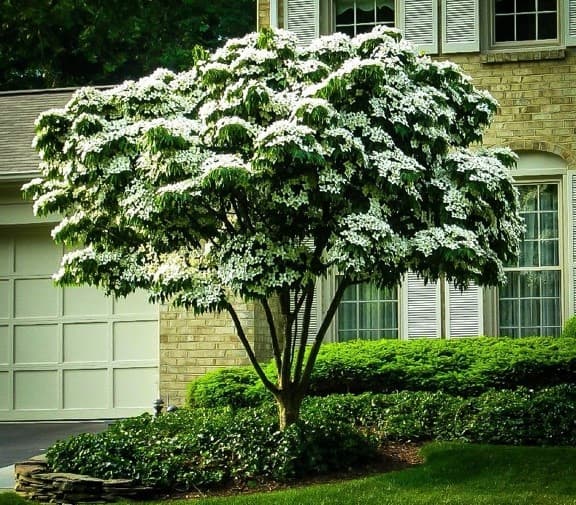
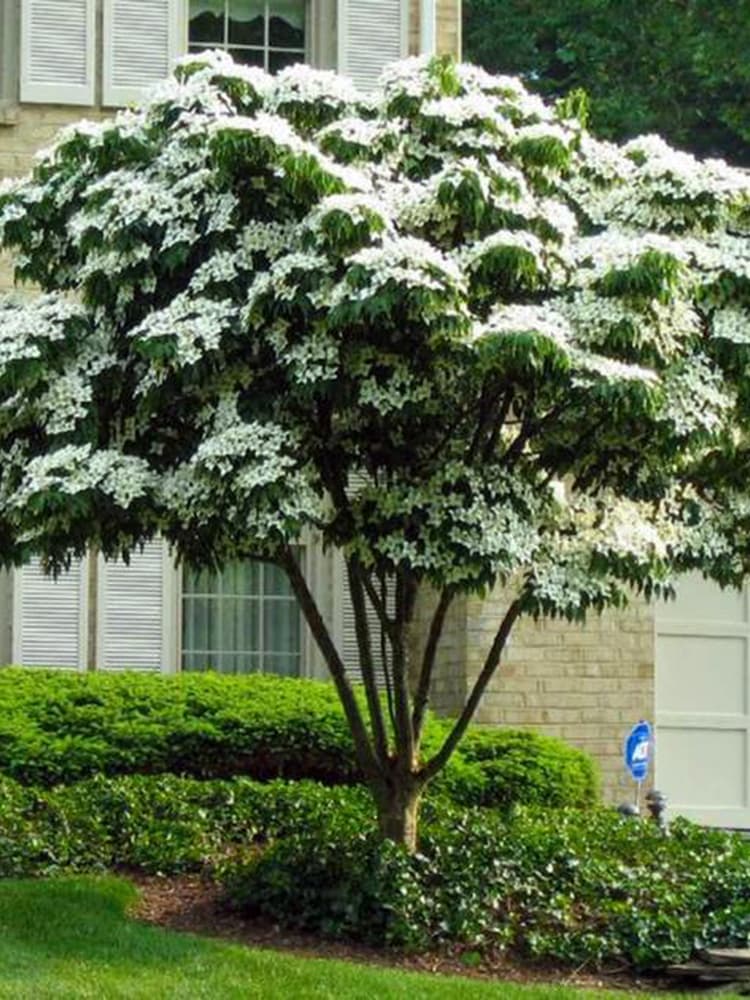
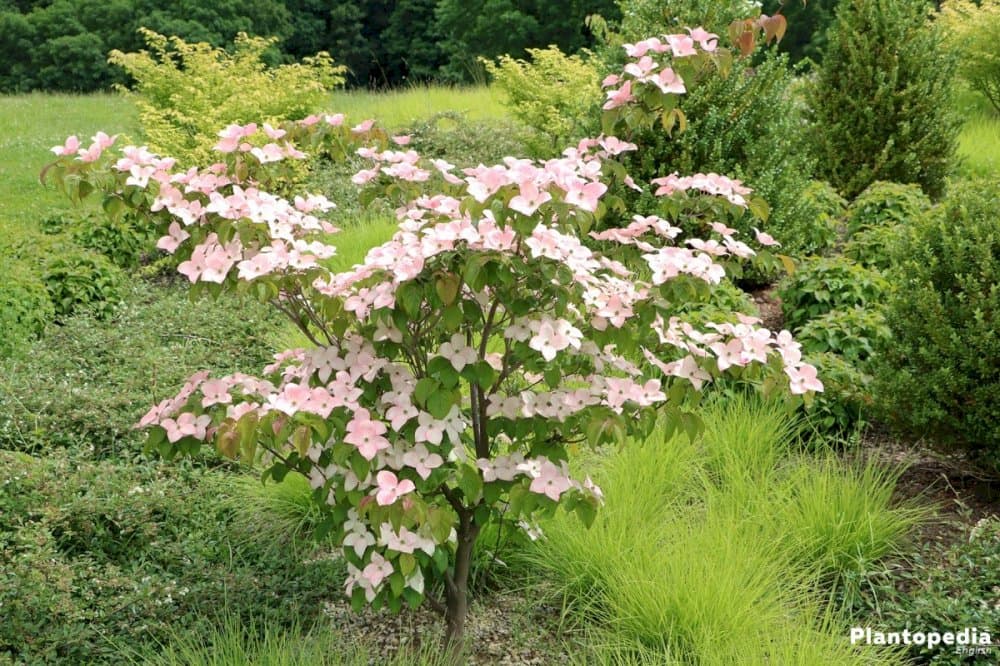
ABOUT
The Cornus kousa 'Schmetterling', commonly known as the Kousa dogwood, is a visually striking plant that is admired for its ornamental qualities. Its structure is characterized by a vase-shaped form that presents a layered and spreading appearance, creating a striking silhouette in the landscape. One of the most distinctive features of the Kousa dogwood 'Schmetterling' is its floral display. The plant boasts large, showy blooms that are not true flowers but actually modified leaves called bracts. These bracts are typically white, but they can develop hints of pink as they age. They surround small, greenish-yellow flowers that are grouped in the center. The flowering bracts are pointed at the tips, giving them a somewhat butterfly-like appearance, which is likely the inspiration for the cultivar name 'Schmetterling', meaning 'butterfly' in German. Following the blooms, the Kousa dogwood 'Schmetterling' produces berry-like fruits. These are pink-red orbs that add further interest to the plant's appearance in the late summer and autumn. The fruits are attractive to birds, making the Kousa dogwood a good choice for wildlife gardens. The leaves of the 'Schmetterling' are oval to elliptical in shape, with pointed tips and entire margins. During the growing season, the foliage is a healthy green, providing a lush backdrop for the flowers. In the autumn, the leaves undergo a transformation and develop brilliant colors ranging from crimson to purple, contributing to the plant's season-long appeal. Additionally, the bark of the Kousa dogwood 'Schmetterling' is an element of visual interest throughout the year. As the plant matures, the bark exfoliates to reveal a mottled pattern of tan, gray, and brown, adding texture and contrast, especially during the winter months when the leaves have fallen. Overall, the Kousa dogwood 'Schmetterling' is a multifaceted plant that offers a stunning visual display through its unique flowers, attractive fruits, seasonally changing foliage, and ornamental bark. It is a favored choice for gardeners looking to enhance their landscape with a plant that provides beauty across multiple seasons.
About this plant
 Names
NamesFamily
Cornaceae.
Synonyms
Kousa Dogwood, Chinese Dogwood, Korean Dogwood, Japanese Dogwood.
Common names
Cornus kousa 'Schmetterling'.
 Toxicity
ToxicityTo humans
The Kousa dogwood is generally considered to have a low toxicity level for humans. Most parts of the Kousa dogwood, including the fruit, are not toxic when ingested. In fact, the fruit is sometimes eaten in small quantities and is used in making wine and jams. However, as with any non-culinary plant, consumption of large amounts could potentially cause stomach upset or discomfort due to the presence of unknown compounds or simply because the human digestive system is not accustomed to processing it.
To pets
The Kousa dogwood is regarded as safe and non-toxic to pets, including dogs and cats. If ingested, it typically does not lead to poisoning or any severe health issues. Nonetheless, overconsumption of any plant material can result in gastrointestinal upset such as vomiting or diarrhea in pets, so it is still advised to prevent pets from eating large amounts of the plant. If your pet displays symptoms after consuming any part of the Kousa dogwood, it is best to consult with a veterinarian.
 Characteristics
CharacteristicsLife cycle
Perennials
Foliage type
Deciduous
Color of leaves
Green
Flower color
White
Height
15-30 feet (4.6-9.1 meters)
Spread
15-30 feet (4.6-9.1 meters)
Plant type
Tree
Hardiness zones
5-8
Native area
East Asia
Benefits
 General Benefits
General Benefits- Ornamental Appeal: Provides aesthetic value with its striking spring blooms, summer berries, and vibrant fall foliage.
- Drought Resistance: Once established, it has the ability to withstand periods of low water availability.
- Pest and Disease Resistance: Generally resistant to many pests and diseases, minimizing the need for chemical treatments.
- Wildlife Attraction: Produces berries that are a food source for birds and other wildlife.
- Low Maintenance: Requires minimal pruning and care once established, making it suitable for busy gardeners.
- Year-Round Interest: Offers visual interest throughout the seasons, with flowers, fruit, and autumn leaf color.
- Urban Tolerant: Able to thrive in urban environments with pollution and compacted soil conditions.
- Cold Hardy: Tolerates cold temperatures and is suitable for growing in a variety of climates.
 Medical Properties
Medical Properties- This plant is not used for medical purposes.
 Air-purifying Qualities
Air-purifying QualitiesThis plant is not specifically known for air purifying qualities.
 Other Uses
Other Uses- Creative Arts: The striking blooms and shape of the Kousa dogwood make it a popular subject for photography and botanical illustrations.
- Educational Tool: Its unique fruiting characteristics can be used to teach about pollination and fruit development in botany classes.
- Culinary Experiments: The edible fruits of the Kousa dogwood can be used to make exotic jams, jellies, and wine with a unique flavor.
- Woodworking: The wood of the Kousa dogwood is hard and dense, making it suitable for crafting small items like tool handles and intricate carvings.
- Ink Production: The bark and fruit can be used to produce natural dyes or inks for art and fabric dying.
- Seasonal Decorations: The branches and berries can be used in floral arrangements and wreaths, especially during autumn and winter.
- Cultural Symbolism: In some cultures, the Kousa dogwood is a symbol of endurance and perseverance, often used in ceremonial contexts.
- Erosion Control: The robust root system of the Kousa dogwood makes it suitable for planting in areas prone to erosion to help stabilize the soil.
- Habitat Support: The tree provides nesting sites and food for various bird species, contributing to local biodiversity.
- Landscape Architecture: Due to its layered structure and aesthetic appeal, the Kousa dogwood is often used in landscape design to create natural screens or focal points in gardens.
Interesting Facts
 Feng Shui
Feng ShuiThe Kousa Dogwood is not used in Feng Shui practice.
 Zodiac Sign Compitability
Zodiac Sign CompitabilityThe Kousa Dogwood is not used in astrology practice.
 Plant Symbolism
Plant Symbolism- Resilience: The Cornus kousa 'Schmetterling', commonly known as Kousa Dogwood, is a hardy plant that can withstand challenging conditions, symbolizing the ability to endure and thrive despite difficulties.
- Purity: The white, often star-shaped flowers of the Kousa Dogwood are seen as a symbol of purity and innocence.
- Strength: The wood of the Kousa Dogwood is known for being tough and durable, making it a representation of strength and steadfastness.
- Renewal: As a flowering tree that blooms in late spring to early summer, the Kousa Dogwood signifies the idea of renewal and the promise of new beginnings.
- Christian Symbolism: In Christian symbolism, the Dogwood is often associated with the crucifixion of Jesus, as its flowers can appear to form the shape of a cross with rust-tipped edges resembling bloodstains.
 Water
WaterThe Kousa dogwood, which includes the 'Schmetterling' variety, prefers consistently moist soil, especially during drought conditions. It is important to water the plant deeply, which generally means applying 1 to 2 gallons of water for young trees once a week, and more for established trees, depending on weather conditions. During hot and dry spells, watering should be increased to twice a week. An effective method is to use a drip irrigation system or soaker hose to provide a slow, deep watering that reaches the roots. Overhead watering should be avoided to prevent fungal diseases.
 Light
LightThe Kousa dogwood enjoys a spot with full sun to partial shade. It thrives best with morning sunlight and some afternoon shade, particularly in the hotter regions. The ideal lighting condition would provide the plant with at least four to six hours of direct sunlight each day, protecting it from intense late-afternoon sun that could stress the plant.
 Temperature
TemperatureThe Kousa dogwood is hardy and can tolerate a wide range of temperatures, typically from -20°F to 85°F, but it prefer temperatures between 60°F and 75°F for optimal growth. Prolonged temperatures over 85°F may stress the plant, and winter temperatures below -20°F could potentially damage it. The plant is well-adapted to the temperature variations commonly experienced in USDA hardiness zones 5 through 8.
 Pruning
PruningPrune the Kousa dogwood to maintain its shape and remove any dead or damaged branches. This plant benefits from pruning in late winter or early spring before the new growth starts. Light pruning to shape the tree can be done at any time, but extensive pruning should be limited to the dormant season. It’s generally not necessary to prune this tree every year; some light thinning every 2 to 3 years is sufficient.
 Cleaning
CleaningAs needed
 Soil
SoilKousa dogwood 'Schmetterling' thrives in fertile, well-draining soil that is acidic to neutral, with an ideal pH range of 5.5 to 6.5. A mix rich in organic matter such as leaf mold or compost will enhance growth. For the best soil mix, combine equal parts loamy topsoil, peat moss, and pine bark to facilitate good drainage and provide a nutrient-rich environment.
 Repotting
RepottingKousa dogwood 'Schmetterling' trees do not require frequent repotting as they are typically grown outdoors. Young trees may need to be transplanted every 3 to 4 years as they grow, or if they outgrow their current space. Ensure each new location or pot allows ample room for root growth and has proper soil conditions.
 Humidity & Misting
Humidity & MistingKousa dogwood 'Schmetterling' prefers average to high humidity levels. It tolerates the typical range of outdoor humidity well and does not demand special humidity considerations, making it adaptable to most temperate climates without supplemental humidity.
 Suitable locations
Suitable locationsIndoor
Not ideal for indoor planting; needs outdoor space.
Outdoor
Plant in partial shade, acidic soil, mulch well, protect from wind.
Hardiness zone
5-8 USDA
 Life cycle
Life cycleThe Cornus kousa 'Schmetterling', commonly known as Kousa Dogwood, begins its life cycle as a dormant seed which requires a period of cold stratification to germinate. Upon germination in the spring, the seedling grows and establishes a root system, developing into a young plant with distinctive, opposite leaves. Over several years, the Kousa Dogwood matures into a flowering tree, typically blooming in late spring to early summer with showy, white bracts surrounding small, greenish-yellow flowers. After pollination, these flowers develop into globular fruit clusters by late summer to fall, which are eaten by birds that disperse the seeds. The tree goes through a period of dormancy in winter, shedding its leaves, and preserving resources until the next growing season. Throughout its life, the Kousa Dogwood may experience multiple flowering and fruiting cycles, eventually reaching a mature age of 20 to 30 years or more, depending on growing conditions and health.
 Propogation
PropogationPropogation time
Late winter
Cornus kousa 'Schmetterling', commonly known as the Butterfly Kousa Dogwood, is often propagated through semi-hardwood cuttings. The best time to propagate is in late summer, when the wood is partially matured yet still flexible. To propagate using this method, take cuttings that are 4 to 6 inches long, ensuring at least two sets of leaves are present. Remove the lower leaves, and dip the base of the cuttings in rooting hormone to encourage root development. Then, insert the cuttings into a well-drained rooting medium such as a mixture of peat and perlite or sand. The cuttings should be kept in a warm environment with high humidity, making sure the medium remains moist but not waterlogged. With consistent care, roots typically develop within a few weeks to months, after which the new plants can be transplanted into individual pots or directly into the garden.
